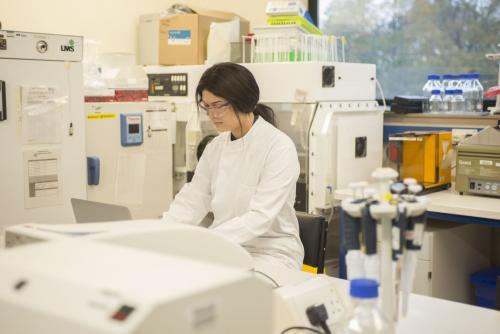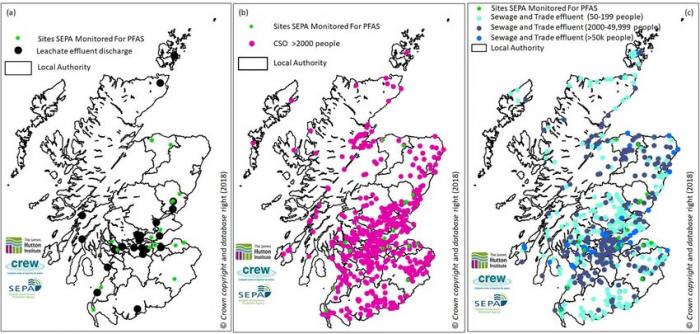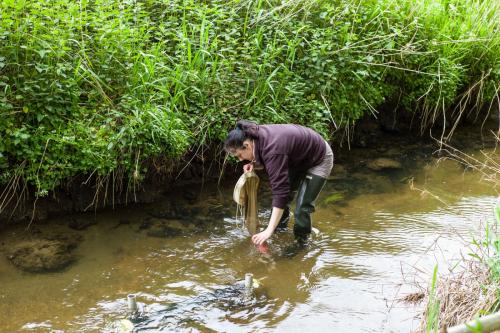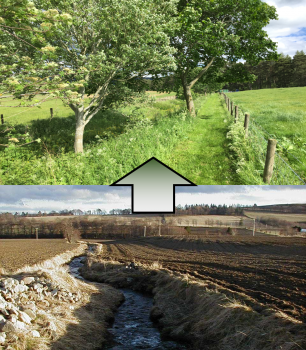Scotland’s rivers – a picture of health or under threat?
Water underpins everything we do. We need clean water to live, but we need waters that are suitable for river life to thrive. With increasing concerns about water pollution, we take a look at what the threats are here in Scotland – and what we can do about them.
Water pollution is increasingly in the public eye in the UK, especially in England and Wales. According to a classification used by the Water Framework Directive, which we inherited from the EU, not a single river in either country currently meets the “good ecological status”.
Across Europe, the figure is better, at 40%, according to the European Environment Agency. In Scotland, it’s even better, with 66% of streams – or surface waters – classified as in a good or better ecological state.
There are a few reasons for the positive picture in Scotland. One has been a concerted effort to address what is called pollution from point sources. That’s where there’s a specific known source of pollution, such as from sewerage systems.
But that’s not to say there’s not room for improvement. Water is also important to Scotland as a nation, for biodiversity, hydropower, agriculture and the whisky industry, drinking water and recreation. So that’s why the Scottish Government’s River Basin Management Plan (2021-2027) sets out how to further improve Scotland’s rivers.
There are also areas of risk that we need to learn more about.
A cocktail of chemicals and antimicrobial resistance
A large one is the increasing number of emerging contaminants threatening our rivers. These include pharmaceuticals and personal care products, endocrine disrupting chemicals that interrupt reproductive systems, persistent organic pollutants and new pesticides – all part of a cocktail of organic and inorganic compounds. We know they’re there. Understanding how they get into rivers and the impact they have is a challenge.
They can include new substances that are not part of regular monitoring that we don't know enough about. They might also occur in very low concentrations, making it hard – and costly – to monitor and therefore understand the impact they’re having.
We have developed analytical methods to monitor pesticides including historic-use pesticides and current-use pesticides in environmental waters, to estimate their flow into the environment and ecological risks, and assess their environmental behavior and potential sources.
We’ve modelled field-level pesticides pollution risk in small drinking water catchment to help understand their impact.
We know some are emerging contaminants like pharmaceuticals, including antibiotics that have passed through humans or animals (via medical and veterinary prescribing) into sewerage systems or via slurry or manure onto the land and then into waters.
These can also enter the environment from private sewerage systems, such as septic tanks, so it can be hard to know how much is going into rivers and from where.
A passive sampler (polar organic chemical integrative sampler – POCIS) deployed in the River Dee for water emergent contaminants monitoring.
By using active and passive sampling techniques, we monitored and found these pharmaceuticals and personal care products in the Scottish priority catchments including the Rivers Ugie and Dee and looked at flow into the North Sea. We’re due to take this to a national scale in Scotland in the next couple of years, to help understand what the priory emerging contaminants are in Scottish waters.
The challenges with antibiotics
When antibiotics enter the environment, it can increase the risk of antimicrobial resistance (AMR) in bacteria. This can affect microbial populations and their ecological functions in our rivers but potentially also the effectiveness of medicine for human treatment, so we need to understand the prevalence of AMR in our natural waters.
This is something our scientists are working on with Heriot-Watt University, the University of Highlands and Islands and the NHS. Initial research identified potential monitoring approaches, but there’s more work to be done. We need to build a baseline of what's happening, what's out there in the streams and what's driving the antimicrobial resistance, so we can start to look at what we could do to reduce it.

Laboratories at The James Hutton Institute.
One part of the solution is to promote pharmaceutical prescribing of medicines that are less harmful to the environment. We’re working with NHS Highland, UHI North Highland’s Environmental Research Institute (ERI), and the University of Nottingham on ways we can do this.
PFAS, the “forever chemicals”
There are other chemicals that we also need to monitor, such as poly- and per-fluoroalkyl substances (PFAS). These are sometimes called “forever chemicals” because they persist so long in the environment. There are many types of PFAS, which have been in use since the 1940s on household goods such as non-stick frying pans.
Due to health concerns, some are banned in the UK, including perfluorooctane sulfonate (PFOS) and perfluorooctanoic acid (PFOA), but there are many that are not banned and they have been detected in many rivers in the UK. Once in rivers, these persistent chemicals could enter aquatic organisms and then the ecological and food chain system. This could have potential impacts on life through bioaccumulation and biomagnification.
Through our work, we have already helped to increase the understanding of the risk PFAS pose to private water supplies.

Spatial relationship between Sites SEPA Monitored For PFAS and (a) Leachate effluent discharge points; (b) Combined Sewage Outflow (CSO) serving >2000 people; and (c) Sewage and Trade effluent discharge points.We’ve also helped look at how to detect these types of chemicals in rivers. More recently, we’ve also looked at ways to manage PFAS chemicals in water.
We are now working on government-funded projects to understand how animals such as salmon would be affected by such chemicals, for example endocrine disruption, impacting reproduction. We will also assess food safety by monitoring the presence of these persistent organic pollutants in the animal tissue.
Eutrophication – when we get too many nutrients in our waters
One of the biggest factors in the failure of fresh water to achieve a good ecological status is agriculture. In fact, it’s the second biggest factor in Europe, behind hydromorphological changes – when we straighten streams or rivers for agricultural drainage, development or navigation.
One of the reasons that agriculture impacts rivers are chemicals that are used in farming, such as fertilisers, as well as outputs from livestock production, such as manure and slurry. These can come from diffuse sources, like pesticides and nutrients that are applied to fields, or specific sources, such as farmyards and slurry lagoons.
When they enter rivers, they can cause eutrophication. This is when there are too many nutrients in the water causing an excess of algae, that can thrive on them, to the detriment of other life. Phosphorus is a particular problem as the main limiting nutrient in running waters.

A lot of our work has focused on phosphorus, one of the major plant nutrients used in farming, and how it can enter streams from fields. This includes estimating risk of pollution coming from septic tanks, when phosphorus is added to catchments with multiple other environmental stressors, looking at the challenges of how to reduce phosphorus-based eutrophication in agricultural landscapes, and systems based approaches to modeling phosphorus pollution risk in order to help develop targeted mitigation measures.
Our work has also included modelling phosphorus pollution risk, to help target effective mitigation measures.
Monitoring isn’t easy
To support a lot of this work, our scientists do routine water sampling, analysing monthly samples taken from rivers. We’re one of eight European partners of the Water Test Network, which helps encourage innovation and update around water testing.
Sampling can be challenging, especially with diffuse sources – when they don’t come from a single point. In this scenario, we need to look at the bigger picture, such as river flow and rainfall, as pollutants from diffuse sources can get washed into streams in high flows.

Sampling suspended sediments in Tarland Burn. Photo by Paul Glendell.
There is specialist equipment in the stream that samples automatically, but they face an inhospitable environment and need regular maintenance. So we’re always working on news ways to be able to detect even very low concentrations of contaminants in the water using sensor technology.
An example of this is in-situ turbidity measurements that can help us to assess phosphorus concentrations in streams. In addition, we have developed new tools to trace sediment sources in streams and identify soil erosion hot-spots in river catchments.
We can also look at other ways to understand how pollution gets into rivers and what we can do about it. Working with the University of Stirling, as part of the MOT4Rivers project, we’re developing a decision support tool which will use river catchment data to develop a pollution model. This could then be used to inform catchment management to prevent or mitigate pollution.
Our research has found a range of antibiotic resistance genes in rivers, and their diversity and abundance clearly increase when there is more impact on the system from agriculture and urbanisation.
Reducing pollution into rivers
But what else can we do about pollution? Reducing how much contaminant gets into rivers is an area of research we have been working on. For example, we have been looking at the potential to add buffers to the landscape, to capture some of this diffuse pollution before it enters the water.
Up until recently, narrow grass margins alongside crops and developed land have been relied upon to do this. But their benefits can be limited and they can be overwhelmed by storms. We have been working with other researchers to develop new concepts and improved designs to better tackle both surface and belowground pollution pathways, as well as methods to place these effectively at key points where pollution can come from fields to watercourses.

We’re also supporting work around the role of trees in improving water quality and river habitats through our involvement in Scotland’s Riverwoods initiative. Many of these skills in planning and developing measures for water retention and water quality are being put to use to benefit water-dependant industries such as Scotland’s distilleries, working to improve their water resources and peatland sustainability.
Prevention rather than cure?
But modeling we have done shows that what is really needed is a reduction in how much phosphorus is applied in order to make a difference. We also need to look at the whole catchment.
How the land is farmed, not just what’s out on it, could also have an impact. Our Centre for Sustainable Cropping at Baldruddery, near Dundee, is trialing integrated cropping, which is moving towards regenerative farming and improving soil health, which helps reduce soil erosion and keeps nutrients in the soil. If scaled up, this has the potential to reduce impacts on a catchment scale.
The impact of climate change
Our research, looking at more than 100 years of river data, has showed that river waters are already increasing in temperature. This can have a number of other impacts. Warmer water can impact whiskey producers, because they need cool water for their processes. This isn’t just a problem for whiskey producers, it’s a problem for river life, including salmon that is so important for Scottish economy and a keystone species for biodiversity.
Warmer waters can also change the way chemicals are processed in the streams. We currently don't know whether that means that even smaller amounts of pollution could lead to impacts that we previously wouldn't have seen. Of course, with less water, there will be less dilution of the water as well.
One way to reduce warming is to increase tree cover around rivers. Modelling by Marine Scotland is being used to target tree planting to help increase shading and reduce water temperatures, for example.
However, this has to be thought through. Trees are not always the answer in some circumstances as they can mobilise phosphorus from the riparian zone into rivers more than if there were not trees in place. We’re looking at this complex picture, including where buffers and trees work together and the role each element has.
The warming climate means that we’re also at greater risk of droughts. We’ve looked at Scotland’s vulnerabilities to drought in particular. It may be surprising that drought is a concern. Yet, last summer the Scottish Environmental Protection Agency (SEPA) used its new Drought Risk Assessment alert system for the first time, asking farmers to stop abstractions of water from rivers when they dropped below a certain level.
Looking more closely at lochs
Lakes and lochs are coming under increasing focus, especially as climate change could mean they contain less and less water.
Here, nitrate, another nutrient applied to the land, is also of concern. We are working on a project funded by CREW looking at nitrate and phosphorus and their impact on lakes. This work follows an initial assessment we undertook through the Centre of Expertise for Waters, which found that the impact of climate change on standing waters such as lochs was already evident, which will likely increase their sensitivity pollution.
Our new work will incorporate climate change scenarios and examine what land management changes could be taken to reduce the adverse effects of climate change on our standing waters.
The UK Centre for Ecology and Hydrology (UKCEH) is leading this project, in which we are modelling the losses of nutrients from the land into lakes and lochs, while UK CEH are looking at what happens when nutrients get into the lake and what in-lake interventions could be beneficial to mitigate the effects of climate change impacts.
Learning more every day
There’s a lot to think about and it can be a complex picture. But that’s why we’re doing the research we do and with every day that passes there are more tools we can use to do this work, from sensor technology to pollution tracking to modelling techniques.
Get in touch if you would like to find out more.
Contributors:








Comments
Post new comment